
|

|
John
Wayne and Larry Flint, and Harry Shapiro from Chicago, a good friend of Jackson Pollock, channeling Frederic Remington
Should you come to Los
Angeles to visit the world headquarters of Just Above Sunset, you collect
your rental car at the airport (LAX) - do get a convertible - and drive up La Cienega Boulevard. Where La Cienega ends
at Sunset Boulevard turn right, and a few blocks down the Strip, beyond the Chateau Marmont, turn left at the Laugh Factory - we’re just up the street.
As you come up La Cienega, though, in the flats below Sunset, on your right you
pass the "Flynt Tower" at Wilshire and La Cienega, now the headquarters of Great Western Savings, but formally the headquarters
of Larry Flynt Enterprises - you know, Hustler magazine and all that. You probably saw the movie - a Czech director, Milos Forman, explaining America’s issues with pornography. Woody Harrelson played Larry Flynt.
John Wayne had passed away and wasn’t available?
So why is there a statue of John Wayne – six tons, twenty-one
feet high, bronze - outside the former Flynt headquarters? Wayne, that nice man from Glendale High School, was not what we
thought?
The answer is pretty ordinary. The Duke was the company's spokesman in their television ads, so when Wayne
died in 1979 Great Western installed a statue of the actor riding a horse on the Hamilton Drive side of the building. The
statute is by Harry Andrew Jackson, whose real name is Harry Shapiro – born in 1924 on the South Side of Chicago. Nothing
out here is ever what it seems.
The statue?
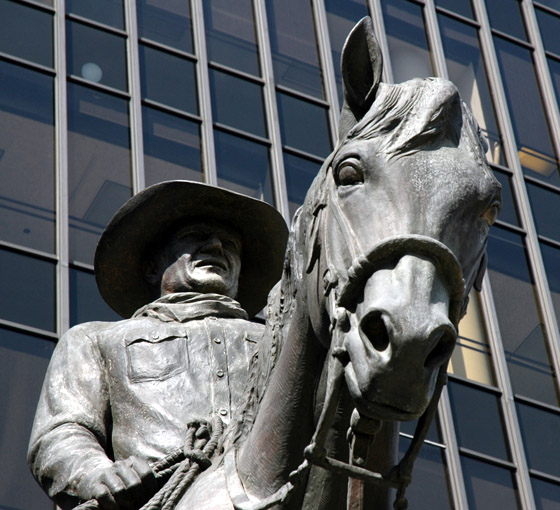
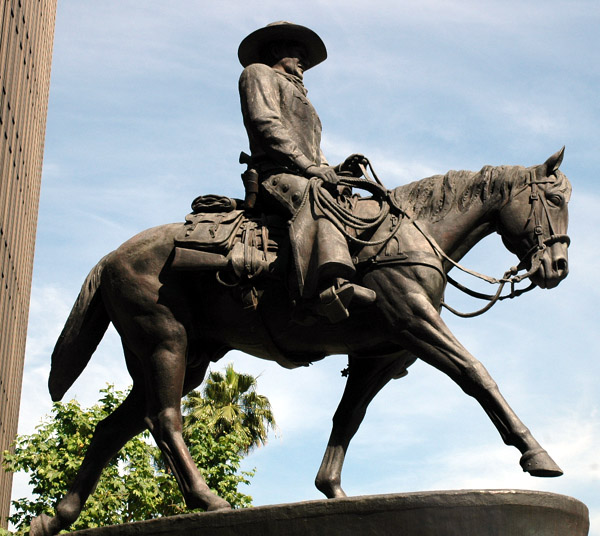
Who is this Harry Jackson?
Some biographical information -
He was raised in a family where his mother ran a cafe near the Stockyards, and his father was
a drunken, violent man. Jackson was often a truant from school and loved to wander around the Harding Museum looking at Frederic
Remington bronzes or to hang out at his mother's cafe listening to stories from the cowboys who had brought their cattle by
trains to the stockyards. A teacher noticed his art talent and got him a scholarship to the Chicago Art Institute's Saturday
children's classes.
At age 14, he ran away from home to Wyoming where he worked at a lumber company and on a ranch.
He regarded these experiences as his spiritual awakening, and his art talents were reinforced by praise from his cowboy peers.
In the late 1930s, he returned to Chicago and studied at the Frederick Mizen Academy, The Chicago Academy of Fine
Arts, and The Chicago Art Institute. In 1942, he entered the Marine Corps and became close to a man who introduced him to
the classics of literature.
In 1943, at Tarawa, he had shrapnel head wounds that caused him epileptic seizures for
most of the remainder of his life, and he also took two bullets to the leg at Saipan. He was then, at age 20, ordered back
to the U.S. where he was appointed an Official Marine Corps Combat Artist, the youngest in Marine history.
Following
discharge, he worked as a radio actor and went to New York with the idea of meeting his hero, Jackson Pollock, whom in 1948
he found to be "a beautiful fantastic man." The two formed a lasting friendship, and Pollock introduced Jackson to Abstract
Expressionism, which helped Jackson express his troubled background. Jackson married artist Grace Hartigan, his first of six
wives, at Pollock's home with Pollock serving as best man.
… The newlyweds went to Mexico and further explored
abstraction, and a year later the couple divorced. Jackson did scenery painting for theatre and television, headed to Europe,
and returned to New York where he did portrait painting and began to break away from Abstract Expressionism, something that
met with disapproval from his peers. He had a Fulbright Travel Scholarship, did some heroic paintings in Denmark, and added
sculpting to his repertoire, a medium inspired on March 4, 1958 when he arrived in Peitrasanta, Italy, where a new foundry
gave him space. He remained in Italy for several years.
In 1966, his entire output of western art was given the first
one-man show at the new National Cowboy Hall of Fame in Oklahoma City. By 1970, he was spending most of his time in Wyoming,
becoming a resident of Cody, and was elected to the Cowboy Artists of America, but got "thrown out" because of his refusal
to choose allegiances between it and the Cowboy Hall of Fame--entities that had had a major falling out.
Jackson's
work is widely held and includes collections of The Vatican… Queen Elizabeth, and the Smithsonian.
Frederic Remington touches?
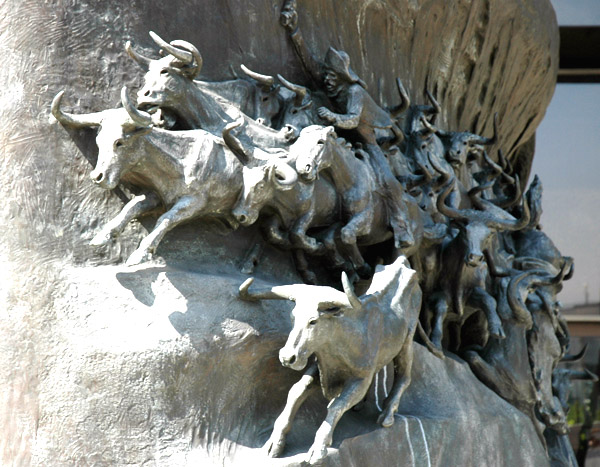
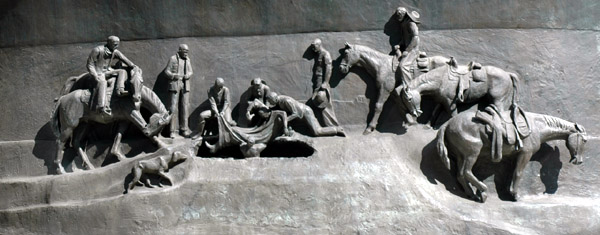
The Duke rides off into
the high-rise office buildings and palms.
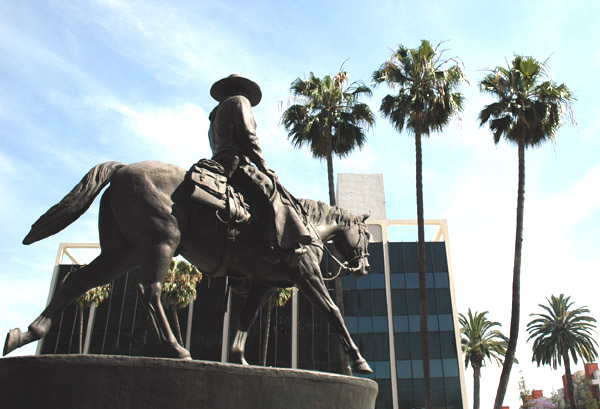
|

|

|

